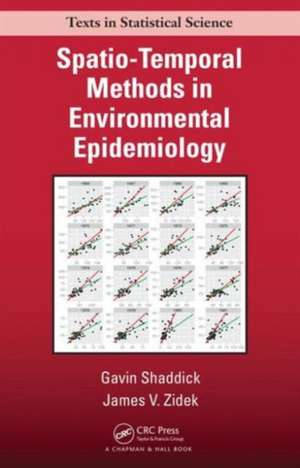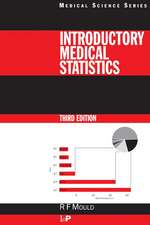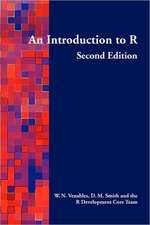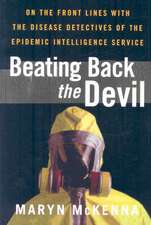Spatio-Temporal Methods in Environmental Epidemiology: Chapman & Hall/CRC Texts in Statistical Science
Autor Gavin Shaddick, James V. Zideken Limba Engleză Hardback – 24 iun 2015
Spatio-Temporal Methods in Environmental Epidemiology is the first book of its kind to specifically address the interface between environmental epidemiology and spatio-temporal modeling. In response to the growing need for collaboration between statisticians and environmental epidemiologists, the book links recent developments in spatio-temporal methodology with epidemiological applications. Drawing on real-life problems, it provides the necessary tools to exploit advances in methodology when assessing the health risks associated with environmental hazards. The book’s clear guidelines enable the implementation of the methodology and estimation of risks in practice.
Designed for graduate students in both epidemiology and statistics, the text covers a wide range of topics, from an introduction to epidemiological principles and the foundations of spatio-temporal modeling to new research directions. It describes traditional and Bayesian approaches and presents the theory of spatial, temporal, and spatio-temporal modeling in the context of its application to environmental epidemiology. The text includes practical examples together with embedded R code, details of specific R packages, and the use of other software, such as WinBUGS/OpenBUGS and integrated nested Laplace approximations (INLA). A supplementary website provides additional code, data, examples, exercises, lab projects, and more.
Representing a major new direction in environmental epidemiology, this book—in full color throughout—underscores the increasing need to consider dependencies in both space and time when modeling epidemiological data. Students will learn how to identify and model patterns in spatio-temporal data as well as exploit dependencies over space and time to reduce bias and inefficiency.
| Toate formatele și edițiile | Preț | Express |
|---|---|---|
| Paperback (1) | 265.78 lei 6-8 săpt. | |
| CRC Press – 31 mar 2021 | 265.78 lei 6-8 săpt. | |
| Hardback (1) | 534.98 lei 6-8 săpt. | |
| CRC Press – 24 iun 2015 | 534.98 lei 6-8 săpt. |
Din seria Chapman & Hall/CRC Texts in Statistical Science
- 5%
 Preț: 650.11 lei
Preț: 650.11 lei - 9%
 Preț: 579.76 lei
Preț: 579.76 lei - 8%
 Preț: 547.81 lei
Preț: 547.81 lei - 5%
 Preț: 838.33 lei
Preț: 838.33 lei - 9%
 Preț: 595.18 lei
Preț: 595.18 lei - 9%
 Preț: 623.03 lei
Preț: 623.03 lei - 8%
 Preț: 544.76 lei
Preț: 544.76 lei - 9%
 Preț: 641.61 lei
Preț: 641.61 lei - 8%
 Preț: 508.20 lei
Preț: 508.20 lei - 8%
 Preț: 551.99 lei
Preț: 551.99 lei - 9%
 Preț: 1115.11 lei
Preț: 1115.11 lei - 9%
 Preț: 641.93 lei
Preț: 641.93 lei -
 Preț: 341.43 lei
Preț: 341.43 lei - 8%
 Preț: 536.31 lei
Preț: 536.31 lei -
 Preț: 357.60 lei
Preț: 357.60 lei - 8%
 Preț: 444.54 lei
Preț: 444.54 lei - 9%
 Preț: 578.22 lei
Preț: 578.22 lei -
 Preț: 371.71 lei
Preț: 371.71 lei - 9%
 Preț: 806.41 lei
Preț: 806.41 lei - 9%
 Preț: 602.46 lei
Preț: 602.46 lei - 9%
 Preț: 593.61 lei
Preț: 593.61 lei - 9%
 Preț: 608.09 lei
Preț: 608.09 lei - 8%
 Preț: 496.58 lei
Preț: 496.58 lei - 9%
 Preț: 610.94 lei
Preț: 610.94 lei - 20%
 Preț: 541.42 lei
Preț: 541.42 lei -
 Preț: 355.66 lei
Preț: 355.66 lei - 8%
 Preț: 516.75 lei
Preț: 516.75 lei -
 Preț: 349.10 lei
Preț: 349.10 lei - 9%
 Preț: 568.64 lei
Preț: 568.64 lei - 8%
 Preț: 465.05 lei
Preț: 465.05 lei - 9%
 Preț: 580.81 lei
Preț: 580.81 lei - 9%
 Preț: 617.41 lei
Preț: 617.41 lei - 9%
 Preț: 595.91 lei
Preț: 595.91 lei -
 Preț: 388.08 lei
Preț: 388.08 lei -
 Preț: 356.64 lei
Preț: 356.64 lei - 8%
 Preț: 547.38 lei
Preț: 547.38 lei - 9%
 Preț: 599.19 lei
Preț: 599.19 lei -
 Preț: 316.73 lei
Preț: 316.73 lei - 9%
 Preț: 638.87 lei
Preț: 638.87 lei -
 Preț: 349.46 lei
Preț: 349.46 lei -
 Preț: 372.50 lei
Preț: 372.50 lei - 8%
 Preț: 439.81 lei
Preț: 439.81 lei - 11%
 Preț: 686.52 lei
Preț: 686.52 lei - 8%
 Preț: 510.14 lei
Preț: 510.14 lei - 8%
 Preț: 511.07 lei
Preț: 511.07 lei - 8%
 Preț: 563.73 lei
Preț: 563.73 lei - 18%
 Preț: 713.39 lei
Preț: 713.39 lei - 15%
 Preț: 684.84 lei
Preț: 684.84 lei - 22%
 Preț: 371.94 lei
Preț: 371.94 lei
Preț: 534.98 lei
Preț vechi: 709.29 lei
-25% Nou
Puncte Express: 802
Preț estimativ în valută:
102.38€ • 106.49$ • 84.52£
102.38€ • 106.49$ • 84.52£
Carte tipărită la comandă
Livrare economică 12-26 aprilie
Preluare comenzi: 021 569.72.76
Specificații
ISBN-13: 9781482237030
ISBN-10: 1482237032
Pagini: 400
Ilustrații: 52 colour illustrations, 8 colour tables
Dimensiuni: 156 x 234 x 25 mm
Greutate: 1.02 kg
Ediția:1
Editura: CRC Press
Colecția Chapman and Hall/CRC
Seria Chapman & Hall/CRC Texts in Statistical Science
ISBN-10: 1482237032
Pagini: 400
Ilustrații: 52 colour illustrations, 8 colour tables
Dimensiuni: 156 x 234 x 25 mm
Greutate: 1.02 kg
Ediția:1
Editura: CRC Press
Colecția Chapman and Hall/CRC
Seria Chapman & Hall/CRC Texts in Statistical Science
Cuprins
Why spatio-temporal epidemiology? Modelling health risks. The importance of uncertainty. Embracing uncertainty: the Bayesian approach. The Bayesian approach in practice. Strategies for modeling. Is ‘real’ data always quite so real? Spatial patterns in disease. From points to fields: modelling environmental hazards over space. Why time also matters. The interplay between space and time in exposure assessment. Roadblocks on the way to causality: exposure pathways, aggregation and other sources of bias. Better exposure measurements through better design. New frontiers. Appendices. References. Indices.
Recenzii
"The authors of this text, both accomplished researchers in the area, provide a much-needed consolidation of spatio-temporal modelling methods…The textbook condenses many complex topics into accessible and manageable chapters addressing key elements of modern spatio-temporal analyses of environmental epidemiologic data…The authors provide helpful R examples throughout…Analytic challenges such as missing data, measurement error, and preferential sampling often arise in environmental epidemiology and are each described in detail along with focused data examples and accompanying code…The text covers a remarkable number of topics in its 318 pages (including many full color graphics and examples of code and output). The structure outlined above provides excellent coverage of many areas of recent development, held together with compelling examples and illustrations…Overall, I found the book a comprehensive overview placing many different topics into a logical perspective with focused, helpful examples. I enjoyed reading the book, am already recommending it to colleagues, and anticipate referring to it often in my future work."
—Lance A.Waller, Emory University, The American Statistician, November 2016
—Lance A.Waller, Emory University, The American Statistician, November 2016
Notă biografică
Gavin Shaddick is a reader in statistics in the Department of Mathematical Sciences at the University of Bath. He received his master’s in applied stochastic systems from University College London and his PhD in statistics and epidemiology from Imperial College London.
His research interests include the theory and application of Bayesian statistics to the areas of spatial epidemiology, environmental health risk, and the modeling of spatio-temporal fields of environmental hazards. Of particular interest are computational techniques that allow the implementation of complex statistical models to real-life applications where the scope over both space and time may be very large.
Dr. Shaddick is actively involved in a number of substantive epidemiological projects related to the effects of air pollution to health. He has worked on many large-scale funded projects, including the high-resolution mapping of environmental pollutants, the utilization of information from multiple sources in estimating exposures to environmental hazards, and the characterization of uncertainty in scenario assessment and policy support.
He is a co-author of the Oxford Handbook of Epidemiology for Clinicians, which was Highly Commended in the Basis of Medicine Category, BMA Book Awards 2013.
James V. Zidek is a professor emeritus in the Department of Statistics at the University of British Columbia. Professor Zidek received his MSc and PhD in statistics from the University of Alberta and Stanford University, respectively.
He began his research career working on Wald’s statistical decision theory. That interest shifted into Bayesian decision analysis. His interest in applications also emerged early in his career and as a consultant, published with engineering collaborators, the first design code for long-span bridges, such as the famous Golden Gate Bridge in San Francisco. The combination of theory and practice led him to an EPA project on acid rain where he, with a few of his collaborators, started to lay the foundations of environmetrics as it is now called, notably on the design of environmental monitoring networks and spatio-temporal modeling of environmental processes. That work led naturally into spatio-temporal epidemiology, which remains an area of interest. He has published about 100 refereed articles and a book on modeling environmental processes.
His contributions to statistics have been recognized by a number of honors. He is a fellow of the ASA, IMS, and Royal Society of Canada; member of the ISI; and a recipient of the Gold Medal of the Statistical Society of Canada (its highest honor).
His research interests include the theory and application of Bayesian statistics to the areas of spatial epidemiology, environmental health risk, and the modeling of spatio-temporal fields of environmental hazards. Of particular interest are computational techniques that allow the implementation of complex statistical models to real-life applications where the scope over both space and time may be very large.
Dr. Shaddick is actively involved in a number of substantive epidemiological projects related to the effects of air pollution to health. He has worked on many large-scale funded projects, including the high-resolution mapping of environmental pollutants, the utilization of information from multiple sources in estimating exposures to environmental hazards, and the characterization of uncertainty in scenario assessment and policy support.
He is a co-author of the Oxford Handbook of Epidemiology for Clinicians, which was Highly Commended in the Basis of Medicine Category, BMA Book Awards 2013.
James V. Zidek is a professor emeritus in the Department of Statistics at the University of British Columbia. Professor Zidek received his MSc and PhD in statistics from the University of Alberta and Stanford University, respectively.
He began his research career working on Wald’s statistical decision theory. That interest shifted into Bayesian decision analysis. His interest in applications also emerged early in his career and as a consultant, published with engineering collaborators, the first design code for long-span bridges, such as the famous Golden Gate Bridge in San Francisco. The combination of theory and practice led him to an EPA project on acid rain where he, with a few of his collaborators, started to lay the foundations of environmetrics as it is now called, notably on the design of environmental monitoring networks and spatio-temporal modeling of environmental processes. That work led naturally into spatio-temporal epidemiology, which remains an area of interest. He has published about 100 refereed articles and a book on modeling environmental processes.
His contributions to statistics have been recognized by a number of honors. He is a fellow of the ASA, IMS, and Royal Society of Canada; member of the ISI; and a recipient of the Gold Medal of the Statistical Society of Canada (its highest honor).
Descriere
This is the first book of its kind to specifically address the interface between environmental epidemiology and spatio-temporal modeling. The book links recent developments in spatio-temporal methodology with epidemiological applications. Drawing on real-life problems, it provides the tools required to exploit recent advances in methodology when assessing the health risks associated with environmental hazards. The text includes practical examples together with embedded R code, details of specific R packages, and other software, including WinBUGS/OpenBUGS and INLA.















